There are currently debates among scientists about the impact coyotes can have on deer populations. Deer managers have picked up on this debate and are seeking information about the potential impacts of coyotes on deer. Fortunately there are multiple recent, high quality research projects that address this question. These studies show that coyotes can significantly reduce fawn survival. One research project in Alabama showed an increase in fawn survival of more than 140% after intensive trapping of coyotes on a 2,000 acre private property. Another research project based in South Carolina placed transmitters in the birth canal of dozens of does to be expelled upon fawns birthing. They found that more than half of the fawns were consumed by coyotes within hours of their birth.
As fawn recruitment and deer densities decrease over portions of their range, it is forcing state agencies to reconsider their harvest limits. Many biologists think that coyotes can’t be controlled, so the only solution is limiting hunter harvest of deer. Every hunter in the field is a deer manager. Hunters can discriminate for age and sex classes before harvesting a deer. Coyotes do not discriminate and will take down a mature buck, doe or fawn in order to fill their stomachs.
The approach of reducing hunter opportunity by lowering the doe/buck harvest will have ramifications for years to come. Hunter retention and hunter numbers have been on a downward trend for several years. Hunters and the fees they pay impact a huge number of conservation programs in each state. Hunter dollars drive many local economies that would not survive if it weren’t for the business of hunters during deer season. Reducing hunter opportunities could easily have an economic impact felt by the non-hunting community.
Reducing coyote populations requires effort (manpower) and resources (dollars). I know that most state agencies don’t have the budget to remove coyotes on a statewide basis. Private landowners can, however, bring resources to bear against coyotes. Hunters, landowners and state agencies need to work together to control coyote predation.
Private landowners were crucial to the restocking efforts that restored the current deer herds throughout the whitetail’s range. They protected deer, created habitat for deer, and allowed deer to be trapped and moved so others could enjoy this wonderful natural resource. I’m confident many landowners will want to protect their current deer herds from being significantly decreased in numbers, despite the fact that they’ve been told coyote populations can’t be controlled.
We all make choices every day. We favor flowers and our food plants by removing weeds either actively or by purchasing these products. We eat beef from pastures where weeds are controlled to ensure there’s enough grass. The US government successfully removes coyotes to protect farmers’ livestock. Why then can’t enough coyotes be removed to protect deer herds?
I agree that it is almost impossible to eliminate coyotes from a property. However, I’m 100% confident, based on experience, that coyote populations can be significantly reduced. I’m also very confident that many landowners, co-ops, lease holders, and other wildlife managers, will spend their resources reducing coyotes. They simply need the permission along with appropriate seasons and tools to pursue coyotes at the correct time of year. Coyotes removed just before or during fawning/nesting season will save more fawns and turkey poults than coyotes removed during the traditional winter trapping season.
Some states currently allow these tools and others don’t. In either case, I encourage hunters to work with state agencies to ensure whitetail populations don’t follow the trend of elk populations. Wolves have significantly reduced elk populations, the opportunities for families to interact with elk and the revenue generated by elk viewing and hunting.
I encourage state wildlife management agencies to allow deer managers to use all ethical tools to remove coyotes. The resources required to remove coyotes will certainly be self-limiting in most cases. Choosing not to manage coyotes where they are a problem is simply saying you refuse to manage deer and other game species.
I don’t dislike coyotes – in the right balance. To achieve that balance the coyote population must be reduced in many areas of the United States. However, many folks are not able to manage coyotes on their properties under the current regulations to sustain current deer harvest objectives. New guidelines need to be initiated in order to preserve the deer herds that my predecessors worked hard to restore.
This is a simple subject. I hope it is not complicated by politics before it’s too late. I really dislike hearing that the only option to coyote management is to reduce hunter opportunities because coyotes can’t be controlled and are destroying deer populations. If coyotes aren’t controlled, deer densities will decrease and so will the number of hunters and the dollars they generate to conserve and protect all species of wildlife and wild places.
Growing Deer together,
Grant



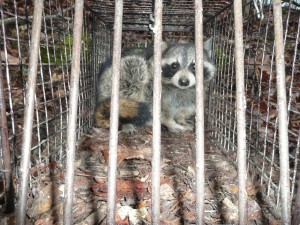 Hens smell very strong if they get wet. Even I can smell them! If it rains and the hen gets wet, it’s very easy for predators such as raccoons to smell the hen or where the hen has walked and trail her to her nest. Once the nest is found by a raccoon, the hen is unable to defend it against a raccoon and all eggs are destroyed. Sometimes the hen is killed while attempting to defend her nest and other times she flees.
Hens smell very strong if they get wet. Even I can smell them! If it rains and the hen gets wet, it’s very easy for predators such as raccoons to smell the hen or where the hen has walked and trail her to her nest. Once the nest is found by a raccoon, the hen is unable to defend it against a raccoon and all eggs are destroyed. Sometimes the hen is killed while attempting to defend her nest and other times she flees.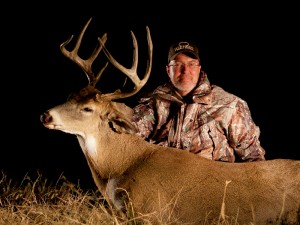 I expected several does and fawns to enter a staging area for that field before dark. I didn’t expect many mature bucks to enter the field unless drawn there by a female fawn that was receptive. During a day with a northwest wind I entered the field from the east and hung a
I expected several does and fawns to enter a staging area for that field before dark. I didn’t expect many mature bucks to enter the field unless drawn there by a female fawn that was receptive. During a day with a northwest wind I entered the field from the east and hung a 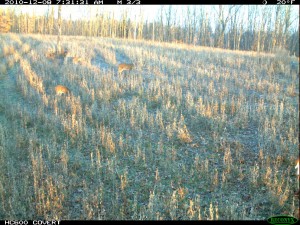
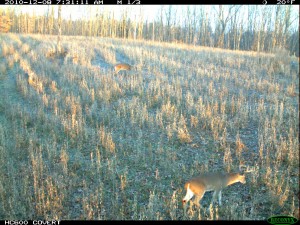
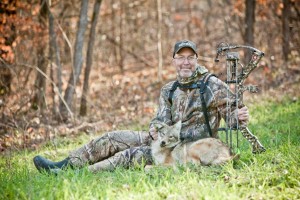 For those and other considerations, I instantly began squeaking (sucking air through tight lips) when I saw the coyote. The cameraman began filming and I readied the Z7. It was only seconds between when I first saw the coyote and when my arrow hit the mark. The first step of making a nice coyote pelt had been completed. I never worry about spooking deer during a hunt when shooting a coyote. Rather I consider the fawns, poults, and adult deer I’m a bit more likely to encounter during the future because I opted to take the shot. What will you do the next time you see a coyote while deer hunting?
For those and other considerations, I instantly began squeaking (sucking air through tight lips) when I saw the coyote. The cameraman began filming and I readied the Z7. It was only seconds between when I first saw the coyote and when my arrow hit the mark. The first step of making a nice coyote pelt had been completed. I never worry about spooking deer during a hunt when shooting a coyote. Rather I consider the fawns, poults, and adult deer I’m a bit more likely to encounter during the future because I opted to take the shot. What will you do the next time you see a coyote while deer hunting?